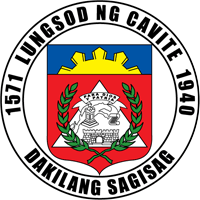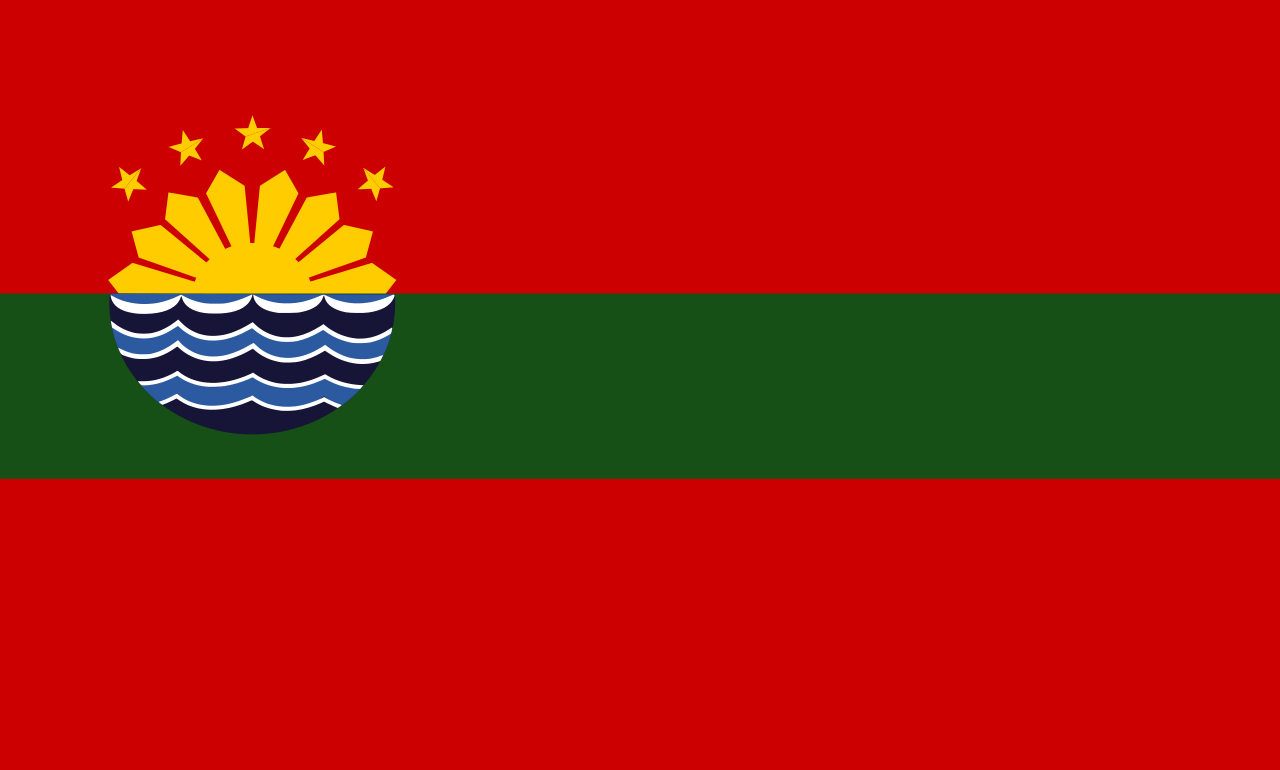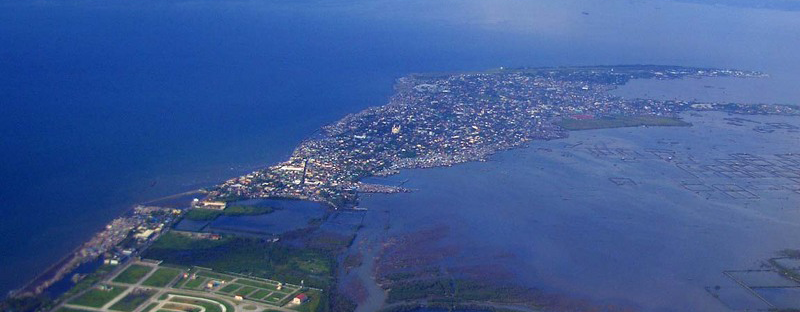Quick Tip
- Brief history
- Geography
- A. The Great Seal of Cavite City
- B. The Cavite City Hymn
- C. The Flag of Cavite City
Symbols of nationhood, statehood, cityhood, etc., has been designed and created since time immemorial to serve as a unifying bond and identity of a nation, state, province or city and even organizations and associations of human beings.
It is the common feeling that the sense of identity, pride and unity of the Caviteños to their beloved and home city and their fellow Caviteños shall be enhanced and enlarged. Thus, the City Seal, City Hymn, City Flag and City March were designed with appropriate symbols meaning based on its geography, history, culture, experience, expectations, vision and dreams of the Caviteño.
1. BRIEF HISTORY
1.1 Origin
The name Cavite evolved from the word “Kawit” or “Cauit,” meaning hook, referring to the shape of the land along the coast of Bacoor Bay. It was mispronounced by the Spaniards as “Kawite” or “Cavite” there being no “K” in the Castilian alphabet, then changing “w” to “v” so as to conform to their accentuation.
There were several names, which were attributed to the present–day Cavite City. Its early settlers, who were the Tagalogs, called it “Tangway,” meaning peninsula and people from other places referred to it as Kawit, because it looked like the sharp-edge part of the hook-shaped land along the seacoast of BacoorBay. In fact, the Chinese traders or the Sangleyes who came here to do business with its natives called it Keit, a clear corruption of the word Kawit.
When the Spaniards came and settled in the most populated area of the place, they christened it as Cavitewhile the old Tangway, which was at its northern tip, was called Cavite la Punta meaning “Tip of Cavite.”When they discovered Cavite La Punta to be a suitable place for the repair and construction of their ships and galleons, they called this place Cavite Nuevo (New Cavite) and decided to move their settlement here and founded the Puerto de Cavite (Port of Cavite).
At the height of the world-famous Manila-Acapulco Galleon Trade, which made Puerto de Cavite the point of entry and departure of Spanish galleons that brought many foreign travelers on its shores, Puerto de Cavite was fondly called “Ciudad de Oro Macizo” meaning “City of Solid Gold.”Chinese Emperor at one time sent some of his men to this place to search for gold.
It was also during those times when it was called “Tierra de Maria Santisima” because of the popularity of the Marian devotion in this place.
1.2 Political History
The early inhabitants of CaviteCity were the Tagalogs ruled by the Kampilan and the bullhorn of a datu, the tribal form of government.
During the Spanish Administration the place was under an “AdministradoresCiviles” called “Gobernadorcillo”, which was later called “Capitan Municipal”, assisted by a “Tiniente Mayor”, a “Tiniente Segundo”, and a “TinienteTercero”, a “Tinientedel Barrio “and” Cabeza de Barangay.
In 1898, when the Americans came, the place was used as the seat of the U.S. Naval Forces in the Philippines. Government Administration was under the “PresidentesMunicipales” with the direct supervision of the American Army Officers.
2. GEOGRAPHY
2.1 Location
Cavite City is a peninsula that is geographically located 8 nautical miles across the bay at 14o 29.04’ latitude, and 120o 54.02’ longitude. It is bounded on the West and Southwest by ManilaBay, on the Northeast by CañacaoBay, on the Southeast by BacoorBay and on the South by the Municipality of Noveleta. It is located at the northern tip of the Province of Cavite and lies approximately 34 kilometers southwest of Manila.
2.2 Area
Base on the Development and Land Use Plan, the total area of CaviteCity is 1,238.63 hectares, broken down as follows:
City Proper - 338.04 ha. (27%) Caballo - 27.37 ha.
Road Network - 61.27 ha. (5%) La Monja - .9758 ha.
Sangley Point -136.791 ha. (11.04%) Corregidor - 546.38 ha.
Fort San Felipe -93.159 ha. (7.5%) El Fraile - 1.098 ha
Corregidor and Adjacent Islands - 609.37 ha. (49%) Carabao -5.55 ha.
Sta. Amalia - 3.9962 ha. Limbones -24.00 ha.
A. The Great Seal of Cavite City

Although the former seal of Cavite City served its purpose well as a symbol of unity, it did not place Cavite City in the proper historical perspective. A new seal designed by Mayor Timoteo O. Encarnacion, Jr. was then adopted through Resolution # 140-90 by the Sangguniang Panlungsod and approved by the Local Chief Executive on September 7, 1990. The National Historical Institute and the President of the Philippines later approved this On November 3, 1993, the Department of Interior and Local Government issued a Certificate of Registration recognizing the New Great Seal of Cavite City,
Shown here is the new great seal of the City of Cavite. The shield or escudo stands for bravery and fortitude. The color red, white and blue, and yellow of the sun and its rays reflect the loyalty of the people of Cavite City to its government. The inclusion of the rays portrays the role of Cavite as one of the original provinces which first rose up in arms against Spanish domination during the Philippine revolution of 1896. It also describes the fact that at the western shores of the City occurs one of the most beautiful sunsets in the world. Inscribed within the escudo over the red portion is a white triangle with the letters KKK at the corners representing the part played by Cavite City in the organization of the Katipunan. Don Ladislao Diwa of the City was one of the triumvirate who organized the patriotic group. There were many Katipuneros from this place. Within the white triangle are the events represented by significant symbols as follows:
1. At the bottom of the triangle is a fort with figures “1872” which was the year of Cavite City Mutiny at the Arsenal de Cavite.
2. At the background is a map of Cavite City including the island of Corregidor, which forms part of the same indicating its form. The heroic and epic struggle at Corregidor is part and parcel of the glorious history of the City.
3. The monument at left of center is in memory of the 13 Martyrs of Cavite who were executed by the Spaniards on September 12, 1896.
4. The musical paper sheet is meant to remember Don Julian Felipe, composer of the Philippine National Anthem.
5. At the bottom of the triangle is the sketch of the Spanish Fort of San Felipe which played an important role in the history of the city and the country, being the place where the 13 Martyrs were detained before they were executed and is also the Fort where the Cavite Mutiny of 1872 took place.
6. Inscribed on the scroll at the uppermost portion of the triangle is the motto of the city in chabacano dialect - “Para Dios y Patria”, (For God and Country) which is “Para sa Diyos at Bayan” in Pilipino. It is in Chabacano to emphasize the native dialect of the City, which is one of its great heritage.
7. The green laurel leaves encircling the right and left portions of the KKK triangle symbolize the victories of the people of Cavite City by reason not only of their bravery in times of war but likewise the progress achieved through all these historical years. The entire design is meant to be a tribute to the fortitude of the Caviteños and their willingness to sacrifice their lives, if necessary, for their country. As a whole it represents loyalty, liberty, justice, hope, peace and progress.
B. The Cavite City Hymn
HIMNO DEL CIUDAD DE CAVITE
By Enrique R. Escalante
(Chabacano Lyrics)
El ciudad donde yo ya naci
Muchos hijos qui ya muri
No mas ya pudi ilos sufri que ta haci
Masque el vida no bale mas pirdi
Ciudad Cavite, ta’qui todos nisos
Para el otro ta pudi sabi
Na todo’l tiempo, na todo’l occasion
Siempre junto nisos de aqui
Ciudad Cavite, el inspiracion
Di niso vida y corazon
Ciudad Cavite, hasta qui muri
Ta dali gracias nisos aqui.
A hymn writing competition was held in the City of Cavite on August 31, 1978 jointly sponsored by the City Government and Division of City Schools. After careful evaluation by Professor Felipe Padilla de Leon, one of the best authorities in the field of music, the hymn composed by the then Kagawad Dominador D. Hugo was selected as the winning entry. In order that this be recognized as the official hymn of the city, Resolution # 83 was then passed by the City Council on October 2, 1978.
The Original version of the Hymn was then translated into Chabacano by Dr. Enrique R. Escalante, a prominent Caviteño, who was then the Superintendent of the Division of City Schools, on September of 1997 in preparation for the celebration of the Centennial of the Philippine Independence in 1998.
C. The Flag of Cavite City

It is very noticeable, especially in some local and foreign functions wherein City residents and officials attend or participate that no city flag has so far been provided or displayed, sometimes, to the embarrassment of the concerned Caviteños. Thus, through the leadership of Mayor Timoteo O. Encarnacion, Jr, the Flag of the City was born. This Flag was conceptualized, designed and interpreted by the Mayor himself and was adopted by the Sangguninang Panlungsod through Resolution # 95-081 dated September 6, 1995 in time for the 55th Foundation Day of the City of Cavite.
The meaning, symbol and significance of the Flag components:
A. The two red strips signify and symbolize the abounding courage and bravery of the Caviteños not only in times of war and adversities but in times of peace as well. The abounding courage to shed bloods or even dies to protect and defend their country and also to defend and die for its values and principles. It likewise symbolizes and signifies the abounding courage to change what needs to be changed for the better, the best and the common good. The courage and bravery to uphold the noble values, tradition and culture of our country and people; and lastly courage and bravery to fight for the progress of the city and country under the principle of justice, liberty and democracy, and under the divine guidance of the everlasting God.
B. The middle green strip symbolizes and signifies the progress and advancement achieved so far by the city and vision and dreams to achieve further progress under a regime of justice, liberty and democracy and under the protection of God Almighty.
C. The half sun, signifying the rising sun, means hope, dreams and visions of the Caviteños for material, physical, moral and spiritual progress; and if the setting sun, to project the fact that at the western shores of the city can be seen one of the most beautiful sunsets, if not in the whole world, in the whole Philippines, The five yellow or gold stars in between the sun rays represent and symbolize the five districts comprising Cavite city, namely: San Roque including Fort San Felipe, San Antonio, including Sangley Point and the Corregidor Island and nearby Islands; Caridad, Sta. Cruz and Dalahican up to Calero Creek.
D. The other half of the imaginary circle below the half sun, composed of three (3) sets of waves, in blue, light blue and white colors signify and symbolize that Cavite City is a peninsula surrounded by sea, while the three (3) sets of navy blue and light blue and white strips symbolize the three bays surrounding Cavite City, namely Cañacao, Bacoor and Manila Bay.
D. Cavite City March
Cavite City March
Music by Maestro Rosauro M. Villareal
Lyrics by Victor A. Rufin
I
The cradle of our country's revolution,
Land of noble heroes and patriots
Intrepid souls that here abound,
Are threats to any aggression.
II
A vanguard of our independence,
A partner to protect and defend.
Virtues of courage and determination,
Would push our goals to end.
CHORUS:
Cavite City, My place, my home,
Privileged and honored I would be.
To serve it’s cherished tradition,
Of bravery and loyalty.
(Repeat I III)
III
A vanguard of our independence,
Always ready to protect and depend Caviteños, Caviteños let us stand proud
Worthy of our history.
On July 13, 2000, Mayor Timoteo O. Encanacion, Jr. endorsed to the Sangguniang Panlungsod the March composition of Maestro Rosauro M. Villareal, a renowned Caviteño artist and composer for possible adoption as the official CaviteCity March. After consultation, analysis and study made by the City Council and by knowledgeable people in the field of music and composition, it is their well-considered opinion that the said composition should be adopted as the official March of Cavite City.
On August 10, 2000, the City Mayor approved Resolution No. 00-81 adopted by the Sangguniang Panlungsod declaring the composition of the late Maestro Rosauro M. Villareal as the official March of the City of Cavite.
After its approval, Mr. Victor A. Rufin, an employee from the Mayor’s Office, wrote the lyrics of the March.

